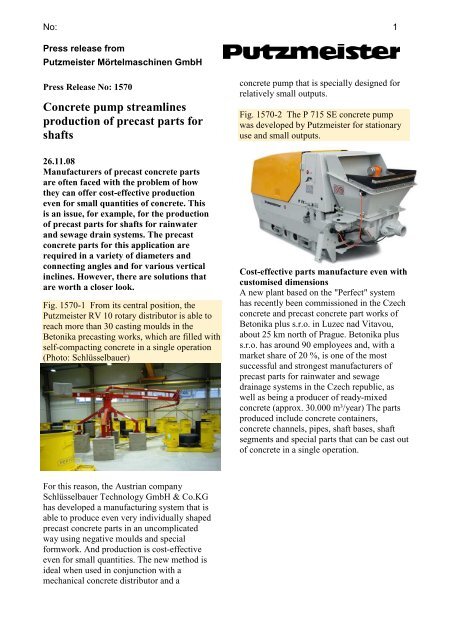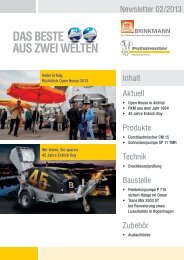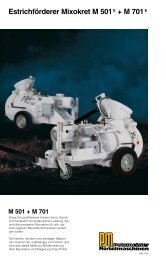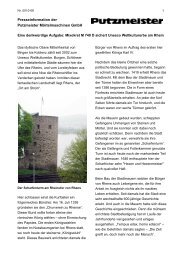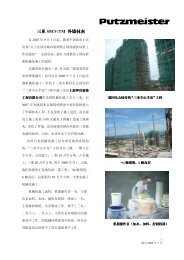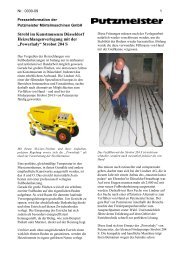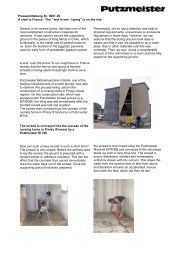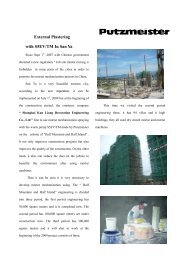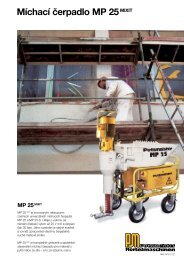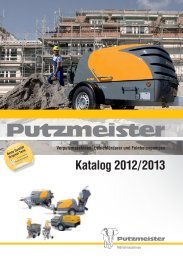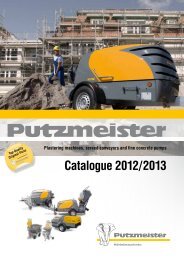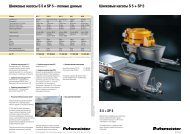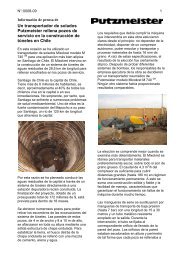Concrete pump streamlines production of precast parts - Putzmeister ...
Concrete pump streamlines production of precast parts - Putzmeister ...
Concrete pump streamlines production of precast parts - Putzmeister ...
Create successful ePaper yourself
Turn your PDF publications into a flip-book with our unique Google optimized e-Paper software.
No: 1<br />
Press release from<br />
<strong>Putzmeister</strong> Mörtelmaschinen GmbH<br />
Press Release No: 1570<br />
<strong>Concrete</strong> <strong>pump</strong> <strong>streamlines</strong><br />
<strong>production</strong> <strong>of</strong> <strong>precast</strong> <strong>parts</strong> for<br />
shafts<br />
26.11.08<br />
Manufacturers <strong>of</strong> <strong>precast</strong> concrete <strong>parts</strong><br />
are <strong>of</strong>ten faced with the problem <strong>of</strong> how<br />
they can <strong>of</strong>fer cost-effective <strong>production</strong><br />
even for small quantities <strong>of</strong> concrete. This<br />
is an issue, for example, for the <strong>production</strong><br />
<strong>of</strong> <strong>precast</strong> <strong>parts</strong> for shafts for rainwater<br />
and sewage drain systems. The <strong>precast</strong><br />
concrete <strong>parts</strong> for this application are<br />
required in a variety <strong>of</strong> diameters and<br />
connecting angles and for various vertical<br />
inclines. However, there are solutions that<br />
are worth a closer look.<br />
Fig. 1570-1 From its central position, the<br />
<strong>Putzmeister</strong> RV 10 rotary distributor is able to<br />
reach more than 30 casting moulds in the<br />
Betonika <strong>precast</strong>ing works, which are filled with<br />
self-compacting concrete in a single operation<br />
(Photo: Schlüsselbauer)<br />
For this reason, the Austrian company<br />
Schlüsselbauer Technology GmbH & Co.KG<br />
has developed a manufacturing system that is<br />
able to produce even very individually shaped<br />
<strong>precast</strong> concrete <strong>parts</strong> in an uncomplicated<br />
way using negative moulds and special<br />
formwork. And <strong>production</strong> is cost-effective<br />
even for small quantities. The new method is<br />
ideal when used in conjunction with a<br />
mechanical concrete distributor and a<br />
concrete <strong>pump</strong> that is specially designed for<br />
relatively small outputs.<br />
Fig. 1570-2 The P 715 SE concrete <strong>pump</strong><br />
was developed by <strong>Putzmeister</strong> for stationary<br />
use and small outputs.<br />
Cost-effective <strong>parts</strong> manufacture even with<br />
customised dimensions<br />
A new plant based on the "Perfect" system<br />
has recently been commissioned in the Czech<br />
concrete and <strong>precast</strong> concrete part works <strong>of</strong><br />
Betonika plus s.r.o. in Luzec nad Vitavou,<br />
about 25 km north <strong>of</strong> Prague. Betonika plus<br />
s.r.o. has around 90 employees and, with a<br />
market share <strong>of</strong> 20 %, is one <strong>of</strong> the most<br />
successful and strongest manufacturers <strong>of</strong><br />
<strong>precast</strong> <strong>parts</strong> for rainwater and sewage<br />
drainage systems in the Czech republic, as<br />
well as being a producer <strong>of</strong> ready-mixed<br />
concrete (approx. 30.000 m³/year) The <strong>parts</strong><br />
produced include concrete containers,<br />
concrete channels, pipes, shaft bases, shaft<br />
segments and special <strong>parts</strong> that can be cast out<br />
<strong>of</strong> concrete in a single operation.
No: 2<br />
Fig. 1570-3 View into a two-part formwork<br />
containing a negative mould made from rigid<br />
polystyrene foam (Photo: Schlüsselbauer)<br />
Shaft bases into which the drain channels run<br />
used to present a particular manufacturing<br />
challenge. In the first <strong>production</strong> step, the<br />
shaft base was made using the traditional<br />
casting method. This was followed by a very<br />
labour-intensive second step where it was<br />
manually clad with ceramic tiles. In the<br />
"Perfect" system, this is solved by the use <strong>of</strong> a<br />
negative mould made from rigid polystyrene<br />
foam that has been cut to the desired<br />
diameter, angle and inclination <strong>of</strong> the channel<br />
and which is held in the two-part formwork.<br />
Fig. 1570-2a The P 715 concrete <strong>pump</strong>,<br />
which has been developed for small outputs,<br />
is located underneath the mixing plant (Photo:<br />
Betonika plus)<br />
Use <strong>of</strong> a concrete <strong>pump</strong> for small quantities<br />
A stationary <strong>Putzmeister</strong> P 715 SE concrete<br />
<strong>pump</strong> is used to <strong>pump</strong> the concrete the 40 m<br />
from the mixing plant to the formwork hall.<br />
With this machine, the output can be reduced<br />
to nearly "zero" if required, which is<br />
important if there are comparatively small<br />
quantities <strong>of</strong> concrete and/or slow concrete<br />
placement. The concrete is poured into the<br />
moulds (average capacity approx. 0.75 m³) by<br />
an elevated, slewable concrete distributor<br />
(<strong>Putzmeister</strong> RV 10) which has a working<br />
radius <strong>of</strong> 20 m. When manufacturing shaft<br />
bases (pipe connections up to DN 600 are<br />
possible), Betonika plus uses self-compacting<br />
concrete. In a two-hour process, all <strong>of</strong> the 30<br />
moulds are filled with about 25 m³ <strong>of</strong> this<br />
material.<br />
Fig. 1570-4 The moulds are filled with selfcompacting<br />
concrete using the <strong>Putzmeister</strong><br />
RV 10 rotary distributor<br />
As the concrete compacts itself, there is no<br />
need for it to be vibrated. This not only<br />
reduces the noise, but also does away with<br />
what used to be an important step in the<br />
<strong>production</strong> process. After the <strong>pump</strong>ing<br />
process, the delivery pipes are easily cleaned<br />
with a water-soaked rubber ball, which is<br />
pushed through the pipe by the <strong>pump</strong> and<br />
caught in a container.<br />
The alternative to concreting using a <strong>pump</strong><br />
and rotary distributor would have been to<br />
install a bucket conveyor. However,<br />
according to Jiri Strobl (Dipl.-Ing.), managing<br />
director <strong>of</strong> the <strong>precast</strong>ing works at Betonika<br />
plus s.r.o. , this solution would have been<br />
considerably more expensive and the overall<br />
<strong>production</strong> <strong>of</strong> the <strong>precast</strong> concrete <strong>parts</strong> would<br />
have been less efficient.<br />
Solutions for larger plants too<br />
As well as this "small-scale solution",<br />
<strong>Putzmeister</strong> also <strong>of</strong>fers more powerful<br />
concrete <strong>pump</strong>s and larger rotary distributors,<br />
as well as hydraulically controlled placing<br />
booms for use in concrete <strong>precast</strong>ing works.<br />
A particularly attractive concreting solution is
No: 3<br />
provided by the AUTOCOR system, in which<br />
the concrete <strong>pump</strong>, mixer and computercontrolled<br />
concrete placing boom - are used to<br />
automate the manufacture <strong>of</strong> <strong>precast</strong> concrete<br />
to a large extent.<br />
Technical data for the P 715 SE concrete<br />
<strong>pump</strong><br />
Pump: 2-cylinder piston <strong>pump</strong><br />
Output: max. 18.2 m³/h<br />
Delivery pressure: 68 bar<br />
Power unit: 400 V / 50 Hz, 30 kW<br />
Length: 4,200 mm<br />
Width: 1,310 mm<br />
Height: 1,180 mm<br />
Contact:<br />
<strong>Putzmeister</strong> Mörtelmaschinen GmbH<br />
Max-Eyth-Str. 10<br />
D-72631 Aichtal, Germany<br />
Tel: 07127 599-0<br />
mm@pmw.de<br />
Author: Bernd Märkert


